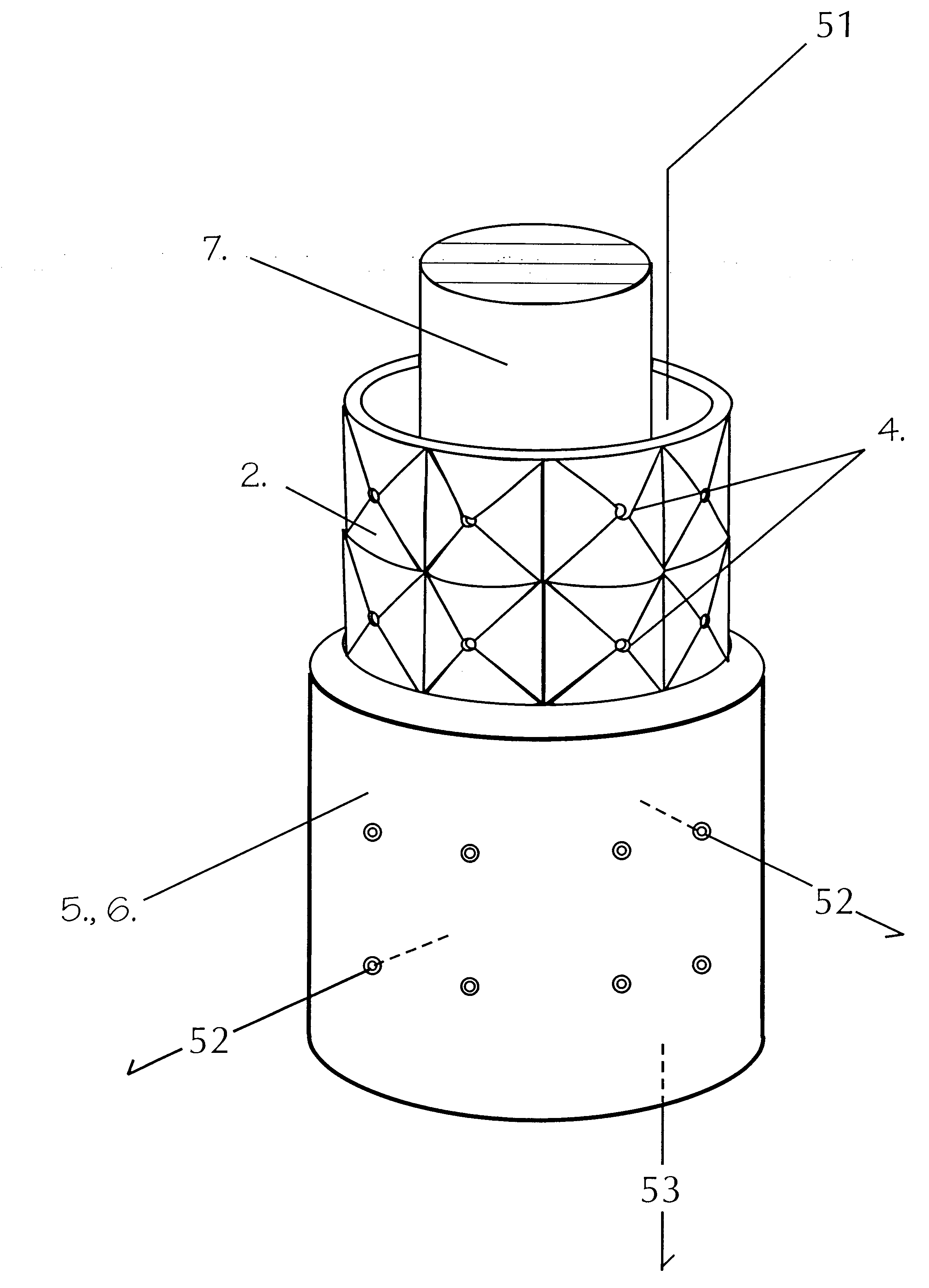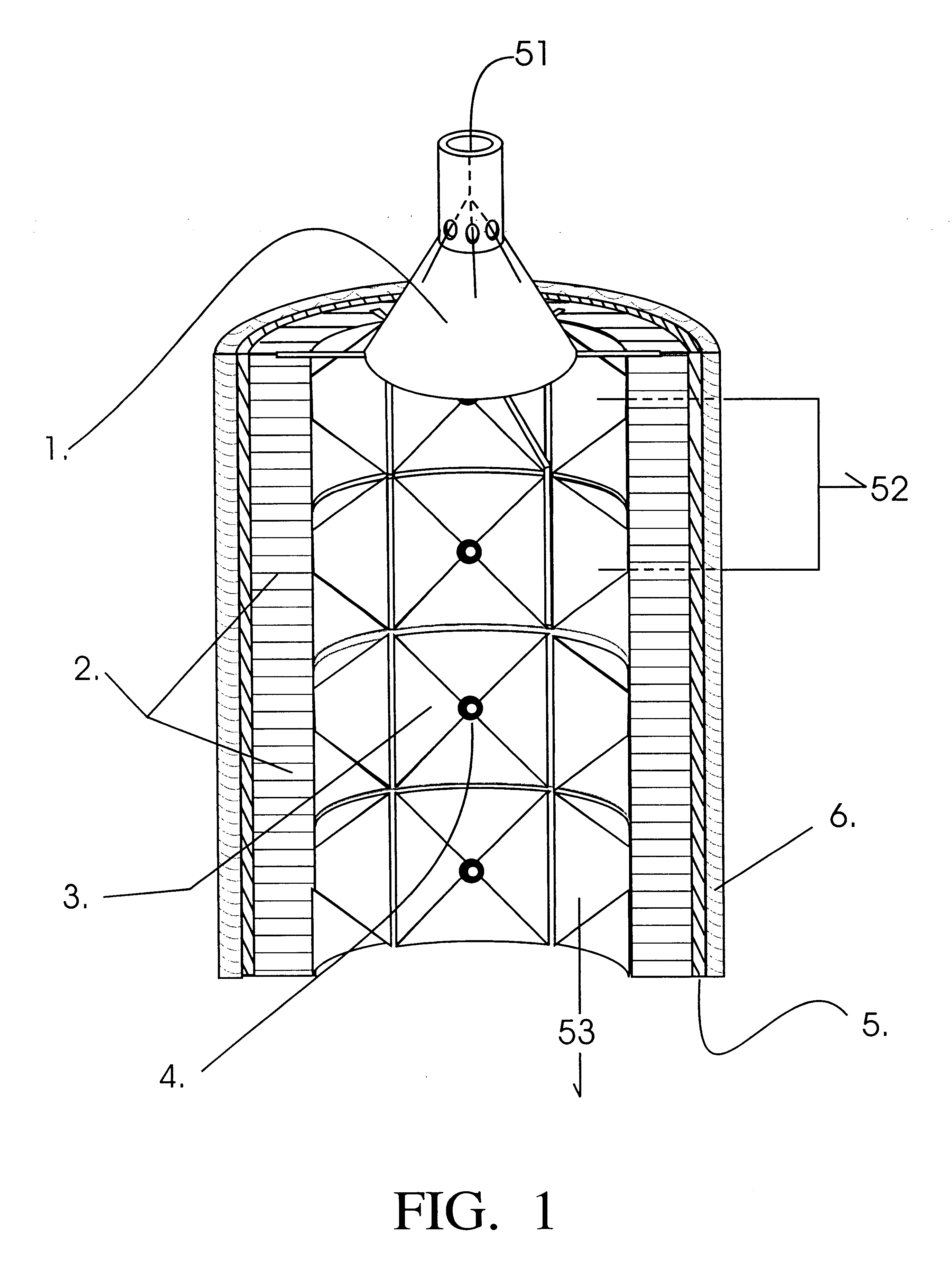Because of material
bursting strength limitations at the required very high
revolutions per minute (RPM's), however, tubal centrifuges are not expected to separate large volumes of fluid; and, because of their batch operating mode (they must be
shut down to transport the heavy materials away from the device), they are also not satisfactory for
continuous operation applications.
The latter problems result in frequent
downtime and maintenance cycles.
In addition to the
noise, vibration, high wear and energy use and high maintenance costs of decanting centrifuges, however, is another limitation, which is the upper limit of their commercial gravity production capacity, which lies between 2,500 and 3,500 gravities and which is thus insufficient to create the density differential required between materials of similar weights, required for the removal of particles smaller than about five microns from a fluid mix.
However this gravity increase would enormously increase the weight of the heavy particles needing to be laboriously scraped along the entire length of the
spinning decanter outer wall, such that the
torsional strength of the
screw conveyor would quickly be exceeded.
And, even if a practical, torsionally stronger
screw conveyor could be designed, the far heavier spun weight of the materials being thrown to the outer wall of such a device would unacceptably increase already high
noise, energy use, wear and maintenance factors.
However it will be shown below that the separating efficiency of a stacked cone core is offset by inefficiency of these devices' transport scheme, namely their single collecting valleys or bulges.
Unfortunately, added plumbing, ejection-valving mechanisms,
nozzle cleaning schemes and other refinements which have been made over the years to improve cone
centrifuge performance, also appear to have substantially increased the complexity,
initial cost and maintenance of this class of device.
As much of an industrial workhorse as they have become, cone centrifuges have an inherent geometry
weakness in their transport scheme itself, which is that their single large beltline accumulation and
discharge valley or zone substantially widens the total outside
diameter of such devices.
Since to accumulate the thrown heavy materials, the single collection valley must form a substantial outermost
diameter bulge in these devices, and since this bulge lies farthest from the axis of spin, rotating this zone and the heavy materials in the fluid flow which stack up in this zone, it necessarily consumes a very large proportion of the total
rotational energy required for such devices, even though this slope valley or zone is only being used for accumulation and ejection, not for separation itself.
However, they too are energy inefficient, due to the shape of the very feature which is most impressive, their non-mechanical transport via sloped geometry.
In addition, like decanting centrifuges, cone type devices also cannot generally remove ultra-
small particles.
As with decanters, material strength has limited the rotational speed which can be attained, generally to below 3,000 gravities in industrial use, such that their achievable density differentials and thus their ability to remove very
small particles from fluid flows, is limited to those generally above a three to five micron
diameter.
To date all major
centrifuge types (tubal, decanting, cone) and all their related transport designs, have of necessity made tradeoffs in such areas as: (1)
processing volume versus particle size (decanters and cones process large volumes but can't remove ultra-
small particles, while tubals can remove small particles but not in high volumes); (2)
continuous operation versus mechanical elegance (decanters and cone centrifuges run continuously but are extremely expensive and complex, while tubals are often models of elegance but generally operate only in batch or semi-batch mode); and (3) the use of basic design elements (geometry plus gravity) to effect transport, versus complicated mechanical transport systems (cone device transport uses sloped surfaces, which reflects design elegance, while decanters use complex
helical scrapers and multi-speed transmissions, which are inherently complex and maintenance prone).
To date no surveyed designs combine all the advantages while minimizing all the disadvantages of prior art.
First, it abolishes the key transport
disadvantage of tubal centrifuges, which is their need to be intermittently stopped for cleaning, while still utilizing their desirable long and tall shape, and, it also eliminates the key transport
disadvantage of decanter centrifuges, which is their mechanically complex, high-energy-using, high-wear mechanical screw transport systems.
In addition, the Density
Screening method eliminates the chief
disadvantage of stacked cone,
nozzle and split-cone type centrifuges, which is the
high energy consumption caused by their particular application of transport slope geometry, in the form of their single large beltline accumulation and
discharge valley or zone that forms the widest part of the outside diameter bulge of such devices, which zone, being furthest from the axis of spin, requires the greatest proportion of the
total energy used for rotation of such devices, even though this zone is only being used for accumulation and ejection, not for separation itself.
This is due to the following logical and geometric limitation: the taller a stack of stack cones in the core of a centrifuge, the broader must be such a device's central beltline collecting valley, in order that such slopes of such valley remain at or greater than the 37 degree
angle of repose necessary to create the sufficient downhill path for collecting the heavy materials thrown from all of the stacked cones, including those at the extreme top and bottom of such a device.
However, there is a second entire domain of the Density Screening outer wall transport method, which is its approach to using materials and fabrication methods undocumented in
spinning centrifuge prior art, in a manner which obtains novel and innovative (in this field) combinations of previously unheard of wear and mechanical advantages, and with far lower construction costs.
Spinning centrifuges face two primary material challenges: wear and abrasion from particles made extremely heavy by
centrifugal force being thrown at the outer surfaces of a device; and,
bursting strength, or that material strength required to keep a centrifuge from exploding or otherwise failing due to the effect of centrifugal force itself on the outer wall.
As stated earlier, wear and abrasion are particularly thorny problems for decanting centrifuges, since they use mechanical scraping schemes for transport.
And, as stated above, their limitations have governed centrifuge development until now.
In those parts of such devices having high-strength requirements, such as all parts to be high-speed rotated out away from the axis of spin where centrifugal force is the highest,
metal parts in final
assembly are often laboriously x-rayed to uncover
metal crystal and / or
welding flaws which would compromise
bursting strength.
The high cost of cast steel and alloys with predictable, uniform
crystal structure and strength, and the equally high cost of
carving, finishing and testing such parts, is well documented.
A single large decanting centrifuge, for example, can cost a million dollars or more.
A
single cone centrifuges, also
metal fabricated, can cost a quarter million dollars or more.
They are cast, carved, further
machine-milled and finished, and, during
assembly, must be dynamically balanced using extremely costly metal fabricating and finishing machinery.
In devices designed to attain comparatively higher rotational speeds, another problem must be addressed, which is
harmonics.
In a centrifugal device, spinning at 2,000 or 3,000 RPM, filled with extremely heavy fluid whose heavier components are being thrown outwards at greatly increased weights due to
gravitational force,
harmonics or misaligned vibrational forces can quickly cause structural failures.
Centrifuge device assemblies for high-speed operation must therefore achieve overall
dynamic balance, and they must be structurally stiff, since flexion can induce wobble or
harmonic vibrations, and they must also be torsionally rigid, since twisting forces in an overall device can also induce destructive
harmonics.
This stainless steel outer cylinder provides minimal structural strength.
 Login to View More
Login to View More 


